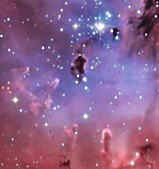25 August 2011
Astrograph 200/800 mm reducer/corrector 2" ASA 2KORRR 0.73x
Ha : OIII = 130:250 min, bicolor technique
Pacman nebula belongs among famous objects of the northern hemisphere in the distance of about 9500 light years from Earth. Diameter of the nebula in space is about 130 light years. It is relatively bright emission nebula with dark dust lanes, globulae, pillars and star-forming region (IC 1590) in the nebula centre. The young very hot stars in the star cluster gives nebula energy to glow. Intense radiation (mainly in ultraviolet part of spectrum) together with strong star wind erodes interior of the nebula and gives it shell like appearence and makes intersting pillar structures. Interesting dust strucutre in the center of the nebula is "Bok globule", kind of object named after astronomer Bart Bok.

NGC 281 is best observable from dark sky places with medium to high aperture scopes through UHC or OIII filter. The image was processed using bicolor technique (R=Ha, G=Ha+OIII, B=OIII) which was brought by Steve Cannistra. As clearly seen from the image, outer areas of the nebula radiates in red light at hydrogen alpha emission line (656.281 nm), whereas in the center dominates radiation of doubly ionized oxygen (495.9 and 500.7 nm).
***
Milos Hroch